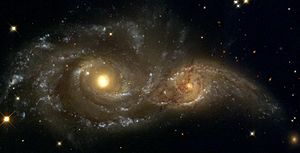NGC 2207 and IC 2163 facts for kids

NGC 2207 and IC 2163 are two amazing spiral galaxies. They are about 80 million light-years away from us. You can find them in the constellation called Canis Major. A famous astronomer named John Herschel first saw them in 1835.
These two galaxies are currently in a cosmic "dance." They are slowly bumping into each other! Scientists have also seen four huge star explosions, called supernovae, happen in NGC 2207. NGC 2207 is actually pulling away stars and gas from IC 2163.
Galaxies in a Cosmic Dance
NGC 2207 and IC 2163 are in the middle of a slow-motion crash. They are not like a car crash, but more like a very slow, gentle bump. This process is called a galactic collision.
What Happens When Galaxies Collide?
When galaxies collide, they don't usually smash into each other head-on. This is because galaxies are mostly empty space. The stars inside them are very far apart. Instead, their gravity pulls on each other. This causes them to stretch and change shape.
Right now, NGC 2207 and IC 2163 are still separate spiral galaxies. They look a bit like two giant pinwheels. They are just starting their collision. This is the very first step of their long merging process.
Future of the Collision
Over millions of years, these galaxies will get closer. They might start to look more like the famous Mice galaxies. The Mice galaxies have long "tails" of stars and gas. These tails are pulled out by gravity during their collision.
In about a billion years, NGC 2207 and IC 2163 are expected to fully merge. When they finish merging, they will become one giant elliptical galaxy. An elliptical galaxy looks more like a big, round or oval ball of stars. This is a common end for many colliding spiral galaxies.

